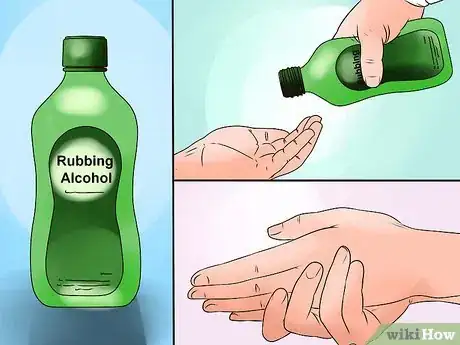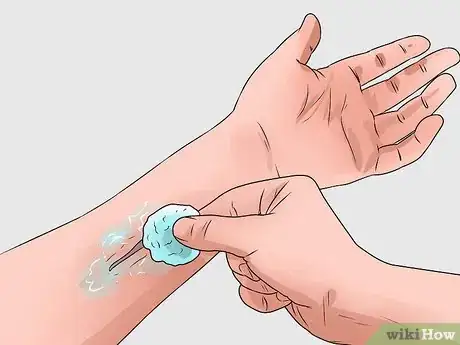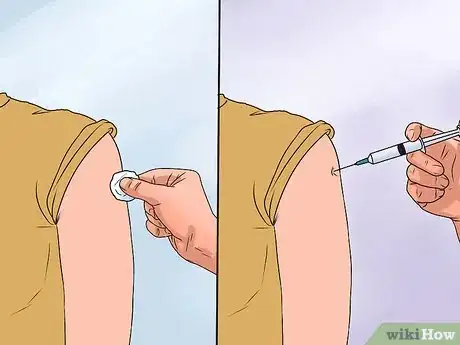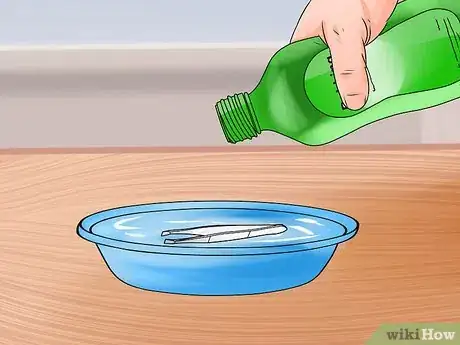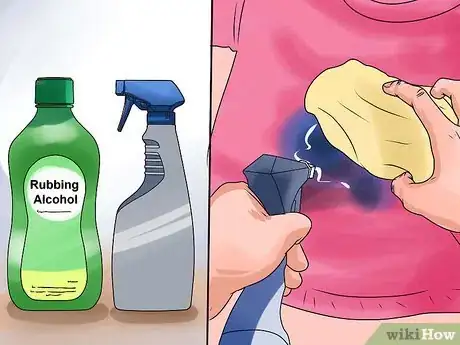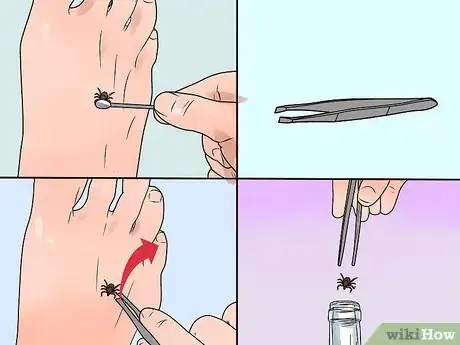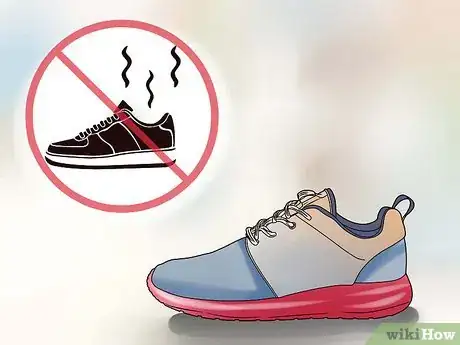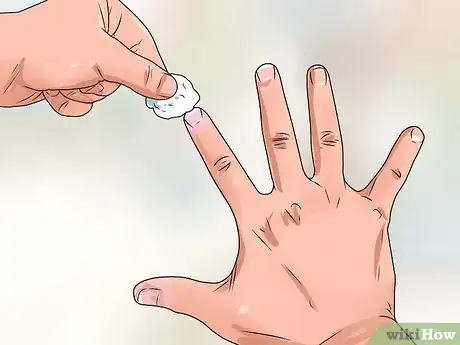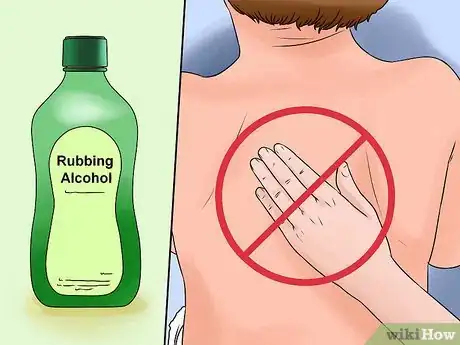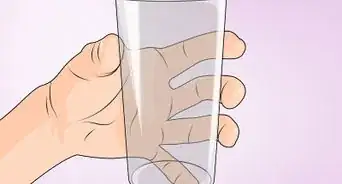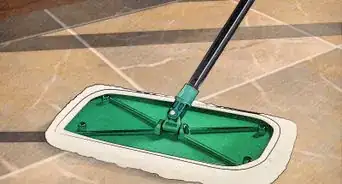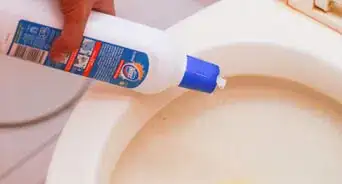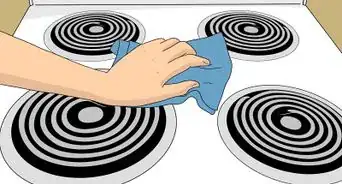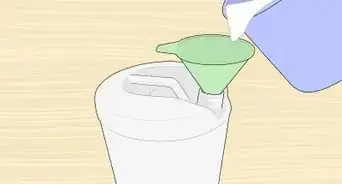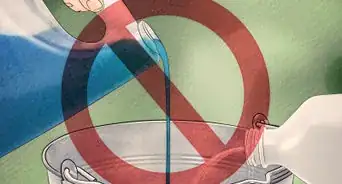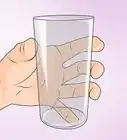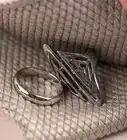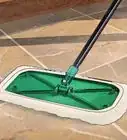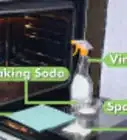This article was medically reviewed by Luba Lee, FNP-BC, MS. Luba Lee, FNP-BC is a Board-Certified Family Nurse Practitioner (FNP) and educator in Tennessee with over a decade of clinical experience. Luba has certifications in Pediatric Advanced Life Support (PALS), Emergency Medicine, Advanced Cardiac Life Support (ACLS), Team Building, and Critical Care Nursing. She received her Master of Science in Nursing (MSN) from the University of Tennessee in 2006.
There are 11 references cited in this article, which can be found at the bottom of the page.
This article has been viewed 158,384 times.
You likely have rubbing alcohol sitting in your medicine cabinet or under your sink. Rubbing alcohol contains either isopropyl alcohol or ethyl alcohol diluted with water. According to the Centers for Disease Control and Prevention (CDC), both of these alcohols can be used as an antiseptic or cleaning agent if the alcohol concentration is at least 60% or higher.[1] However, rubbing alcohol is poisonous if consumed, so seek medical attention immediately if you or someone else drinks it.[2]
Steps
Using Rubbing Alcohol as an Antiseptic
-
1Clean your hands with rubbing alcohol. Rubbing alcohol is a common ingredient in most commercial hand sanitizers. Hand sanitizer is used to disinfect the hands, and does not require soap or water. Simply rubbing hand sanitizer on the hands for approximately 30 seconds, or until the liquid has evaporated, kills the majority of bacteria present. Hand sanitizer often includes additional components, such as a moisturizing element to prevent the hands from drying out, but these components are not necessary. If you are unable to wash your hands with soap and water, or if you want to ensure that your hands are completely clean, rubbing alcohol may be used to disinfect the hands.[3]
- Pour a small amount of rubbing alcohol into the palm of one hand.
- Rub the hands together vigorously for approximately 30 seconds, or until the hands are completely covered and the alcohol begins to evaporate.[4]
- Note that rubbing alcohol and hand sanitizer do not remove dirt from the hands. If your hands are visibly soiled, you may need to wash your hands with soap and water to remove the dirt from your skin.[5]
-
2Treat wounds with rubbing alcohol. One of the most common uses of rubbing alcohol is treating wounds. This is because rubbing alcohol makes an excellent antiseptic. It kills germs by coagulating each germ's protein. Once a germ's protein is solidified, the germ dies rather quickly.[6]
- Pour a small amount of rubbing alcohol on the skin surrounding a wound. This may be particularly helpful for puncture wounds, which can introduce foreign germs into the wound.[7] Once the wound is clean, you can bandage the wound, and seek medical attention as needed.
Advertisement -
3Disinfect skin before an injection. Certain medications, like insulin, need to be injected into the body. Prior to administering an injection, it's important to disinfect the skin to prevent bacteria from being introduced into the body.[8]
-
4Disinfect medical tools. Some household medical tools, like tweezers, can harbor bacteria that could be introduced to a wound. For this reason, it's important to disinfect medical tools before use. You can do this with rubbing alcohol.[12]
- Thoroughly douse the tips of tweezers in rubbing alcohol. Allow the alcohol to dry before use, to ensure that any bacteria on the tweezers have been killed.[13]
-
5Mix equal parts rubbing alcohol and vinegar to prevent swimmer's ear. Combine isopropyl alcohol and white vinegar and put a couple of drops in each of your ears after you shower or swim. Pull on your outer ear to shift your ear canal, which helps the mixture trickle into your ear. Make sure the alcohol-vinegar mixture stays in your ear canal for 3 to 5 minutes.[14]
- It's best to use a rubbing alcohol that's 90-95% isopropyl alcohol for this.
Using Rubbing Alcohol as a Cleaning Agent
-
1Remove stains with rubbing alcohol. Rubbing alcohol can make a surprisingly effective stain remover. Simply mix one part rubbing alcohol with two parts water. You can use this mixture in a spray bottle, or poured on a rag or towel to spot clean stained fabrics.[15]
- Rubbing alcohol can be used to treat grass stains before the wash cycle. Apply the rubbing alcohol mixture to a stain, rubbing the fabric thoroughly. Let it sit for ten minutes, then wash the clothing article as you normally would.[16]
-
2Clean your bathroom with rubbing alcohol. Because of its antiseptic properties, rubbing alcohol is often used to clean high-germ areas like bathrooms. Apply rubbing alcohol to a paper towel and rub bathroom fixtures like faucets, sinks, and toilets to quickly clean and disinfect these surfaces.[17]
-
3Make a window cleaner with rubbing alcohol. In addition to its other cleaning applications, rubbing alcohol can be used to make an effective window cleaner. Just mix one pint of rubbing alcohol with two tablespoons of ammonia and two tablespoons of dish soap. Mix the formula thoroughly, then apply to windows using a spray bottle or sponge.[18]
Finding Other Uses for Rubbing Alcohol
-
1Remove a tick. Some people find that applying rubbing alcohol to a burrowed tick can shock the tick, making it easier to remove. Even if this does not work, experts recommend using rubbing alcohol to kill and preserve a tick after removal. This makes it easier for doctors to determine if the tick was a carrier of Lyme disease.[19]
- Use a clean cotton swab to apply rubbing alcohol to the area where a tick is attached. If you don't have cotton swabs, you can pour a little rubbing alcohol directly onto the skin.[20]
- Use clean tweezers (preferably after sterilizing them, which you can do with rubbing alcohol) to grip the tick's body as close to the surface of your skin as possible.[21]
- Gently pull the tick upward without breaking any part of the tick's body.[22]
- Drop the tick into a jar or bottle filled with a little rubbing alcohol. Be sure the tick is completely submerged.[23]
- Use rubbing alcohol to cleanse the skin's surface where the tick was removed.[24]
-
2Get rid of sneaker odors. Use a spray bottle to apply rubbing alcohol to the inside of sneakers. The rubbing alcohol will kill the bacteria causing the smells, leaving your sneakers clean and odor-free.[25]
-
3Remove nail polish in a pinch. If you're out of nail polish remover, you can use rubbing alcohol in a pinch. Pour some rubbing alcohol onto a cotton swab, and rub hard on your finger nails to remove old nail polish. Nail polish won't come off as easily as with actual nail polish remover, but it will still strip away the old nail polish.[26]
- Rubbing alcohol isn't as effective as commercial nail polish remover. It'll likely take you a while to get your nails totally clean of polish.
-
4Do not use rubbing alcohol to cool feverish skin. A common folk remedy for fevers is to apply rubbing alcohol to the skin. As the alcohol evaporates, it's thought to offer a cooling sensation.[27] However, pouring rubbing alcohol on the body, especially on children, can be extremely dangerous. A number of children have actually slipped into comas after their parents applied rubbing alcohol to treat a fever. For this reason, using rubbing alcohol to relieve the symptoms of a fever is highly discouraged.[28]
Expert Q&A
-
QuestionWill rubbing alcohol reduce the swelling of my ankles and feet?
 Jonas DeMuro, MDDr. DeMuro is a board certified Pediatric Critical Care Surgeon in New York. He received his MD from Stony Brook University School of Medicine in 1996. He completed his fellowship in Surgical Critical Care at North Shore-Long Island Jewish Health System and was a previous American College of Surgeons (ACS) Fellow.
Jonas DeMuro, MDDr. DeMuro is a board certified Pediatric Critical Care Surgeon in New York. He received his MD from Stony Brook University School of Medicine in 1996. He completed his fellowship in Surgical Critical Care at North Shore-Long Island Jewish Health System and was a previous American College of Surgeons (ACS) Fellow.
Board Certified Critical Care Surgeon No, rubbing alcohol will not reduce ankle and feet swelling. Discuss this with your physician. They can determine the cause of this swelling, as well as the next steps to address this.
No, rubbing alcohol will not reduce ankle and feet swelling. Discuss this with your physician. They can determine the cause of this swelling, as well as the next steps to address this.
Warnings
- Do not apply to deep penetrating wounds.⧼thumbs_response⧽
- Do not use rubbing alcohol to cool feverish skin. This is highly dangerous and is not a medically sound method of treating a fever.⧼thumbs_response⧽
- Do not ingest rubbing alcohol. If you do accidentally ingest rubbing alcohol, call your local poison control center or emergency services immediately. Symptoms of this include inebriation, stupor, coma, or even death.⧼thumbs_response⧽
References
- ↑ https://www.cdc.gov/infectioncontrol/guidelines/disinfection/disinfection-methods/chemical.html
- ↑ http://www.cdc.gov/niosh/npg/npgd0359.html
- ↑ http://cid.oxfordjournals.org/content/31/1/136.full
- ↑ http://cid.oxfordjournals.org/content/31/1/136.full
- ↑ http://cid.oxfordjournals.org/content/31/1/136.full
- ↑ https://indianapublicmedia.org/amomentofscience/rubbing-alcohol-good-anticeptic.php
- ↑ http://www.childrenscolorado.org/wellness-safety/is-your-child-sick/puncturewound/puncture-wound-/photos
- ↑ http://www.ncbi.nlm.nih.gov/books/NBK138495/
- ↑ http://www.ncbi.nlm.nih.gov/books/NBK138495/
- ↑ http://www.ncbi.nlm.nih.gov/books/NBK138495/
- ↑ http://www.ncbi.nlm.nih.gov/books/NBK138495/
- ↑ http://www.aafp.org/afp/2004/0601/p2647.html
- ↑ http://www.aafp.org/afp/2004/0601/p2647.html
- ↑ https://www.uofmhealth.org/health-library/za1096
- ↑ http://www.huffingtonpost.com/2015/07/01/uses-for-rubbing-alcohol-_n_7657046.html
- ↑ http://www.huffingtonpost.com/2015/07/01/uses-for-rubbing-alcohol-_n_7657046.html
- ↑ http://www.huffingtonpost.com/2015/07/01/uses-for-rubbing-alcohol-_n_7657046.html
- ↑ http://www.huffingtonpost.com/2015/07/01/uses-for-rubbing-alcohol-_n_7657046.html
- ↑ http://www.cdc.gov/ticks/removing_a_tick.html
- ↑ http://www.huffingtonpost.com/2015/07/01/uses-for-rubbing-alcohol-_n_7657046.html
- ↑ http://www.cdc.gov/ticks/removing_a_tick.html
- ↑ http://www.cdc.gov/ticks/removing_a_tick.html
- ↑ http://www.cdc.gov/ticks/removing_a_tick.html
- ↑ http://www.cdc.gov/ticks/removing_a_tick.html
- ↑ http://www.huffingtonpost.com/2015/07/01/uses-for-rubbing-alcohol-_n_7657046.html
- ↑ http://www.huffingtonpost.com/2015/07/01/uses-for-rubbing-alcohol-_n_7657046.html
- ↑ http://www.nytimes.com/2008/10/07/health/07real.html?_r=0
- ↑ http://www.nytimes.com/2008/10/07/health/07real.html?_r=0
About This Article
To use rubbing alcohol as an antiseptic, pour a small amount into your palms and rub your hands together for 30 seconds. Treat wounds by applying a cotton pad soaked in 60%-70% alcohol to the skin around the affected area, which works to kill germs and prevent the spread of bacteria. Additionally, use rubbing alcohol to clean your bathroom by adding some to a towel or rag and wiping down areas that might carry germs, like toilets or faucet handles. For more uses for alcohol from our Medical reviewer, like how to remove a tick with rubbing alcohol, read on!
